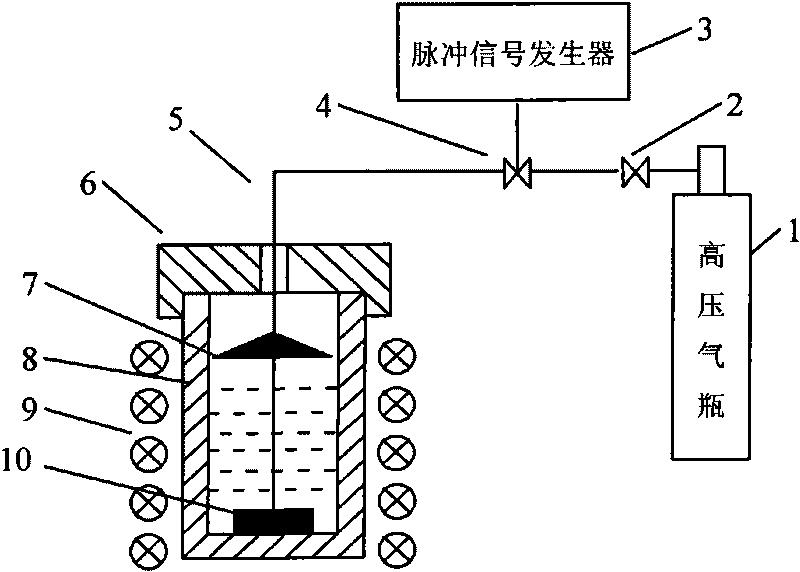Method for preparing metal-based composite material
A composite material and metal-based technology, which is applied in the field of non-ferrous metal preparation and processing, can solve the problems of restricting the common use of stirring casting methods, deterioration of mechanical properties of composite materials, and pollution of metal melts, so as to avoid pollution and the loss of the agitator itself , Reduce the preparation cost and facilitate the operation
- Summary
- Abstract
- Description
- Claims
- Application Information
AI Technical Summary
Problems solved by technology
Method used
Image
Examples
Embodiment 1
[0032] Melt 5kg of aluminum alloy 2024 to 650°C and keep it warm; B with an average particle size of 10μm 4 C particles are poured into the crucible 8, the temperature of the melt is controlled to 650°C through the heating furnace 9, and then the smelted 2024 aluminum alloy is quantitatively poured into the crucible, B 4 C particles account for 15% of the total fraction, and 2024 aluminum alloy accounts for 85% of the total fraction. After installing the protective cover 7 and the crucible cover 6, open the N 2 High-pressure gas cylinder, adjust the pressure reducing valve, pulse signal generator and solenoid valve, the air pressure after decompression is 0.6MPa, and the pulse signal frequency is 3Hz. The pulse air flow is ejected from the nozzle to form periodic bubbles. The bubbles drive the SiC particles at the bottom to float up and disperse into the melt. After 5 minutes of pulse air flow treatment, the SiC particles are basically uniformly dispersed, and the uniformly di...
Embodiment 2
[0034] Melt 3kg of magnesium alloy AZ91 to 640°C and keep it warm; after preheating SiC particles with an average particle size of 5μm in the crucible, pour the melted magnesium alloy AZ91 into the crucible quantitatively, and the SiC particles account for 20% of the total fraction 1. Magnesium alloy AZ91 accounts for 80% of the total integral. Argon is used as the pulse air flow. After decompression, the air pressure is 0.3MPa and the pulse frequency is 10Hz. The pulse air flow is ejected from the ring hole nozzle to form periodic bubbles, which form in the melt With strong turbulent flow, SiC particles are gradually dispersed into the melt. After 3 minutes of pulse gas treatment, SiC particles are evenly dispersed into the melt, and then the melt is cooled to obtain a composite material ingot. The angle α / 2 between the centerline of the nozzle air hole and the nozzle centerline is 60°, the protective cover has a conical structure, and the range of the cone angle β is 170°.
Embodiment 3
[0036]Melt 8kg of pure copper to 1200°C and keep it warm; Al with an average particle size of 20μm 2 o 3 After the particles are preheated, they are poured into the crucible 8, and then the smelted copper melt is quantitatively poured into the crucible, and the Al 2 o 3 Particles account for 5% of the total fraction, and pure copper accounts for 95% of the total fraction. After installing the protective cover 7 and crucible cover 6, open the N 2 High-pressure gas cylinder, adjust the pressure reducing valve, pulse signal generator and solenoid valve, the air pressure after decompression is 0.9MPa, and the pulse signal frequency is 30Hz. The pulse air flow is ejected from the nozzle to form periodic bubbles, and the bubbles drive the Al at the bottom 2 o 3 The particles floated up and dispersed into the melt, and after 1min pulsed airflow treatment, the Al 2 o 3 The particle dispersion is basically uniform, and the uniformly dispersed composite material melt is poured int...
PUM
 Login to View More
Login to View More Abstract
Description
Claims
Application Information
 Login to View More
Login to View More - R&D
- Intellectual Property
- Life Sciences
- Materials
- Tech Scout
- Unparalleled Data Quality
- Higher Quality Content
- 60% Fewer Hallucinations
Browse by: Latest US Patents, China's latest patents, Technical Efficacy Thesaurus, Application Domain, Technology Topic, Popular Technical Reports.
© 2025 PatSnap. All rights reserved.Legal|Privacy policy|Modern Slavery Act Transparency Statement|Sitemap|About US| Contact US: help@patsnap.com



